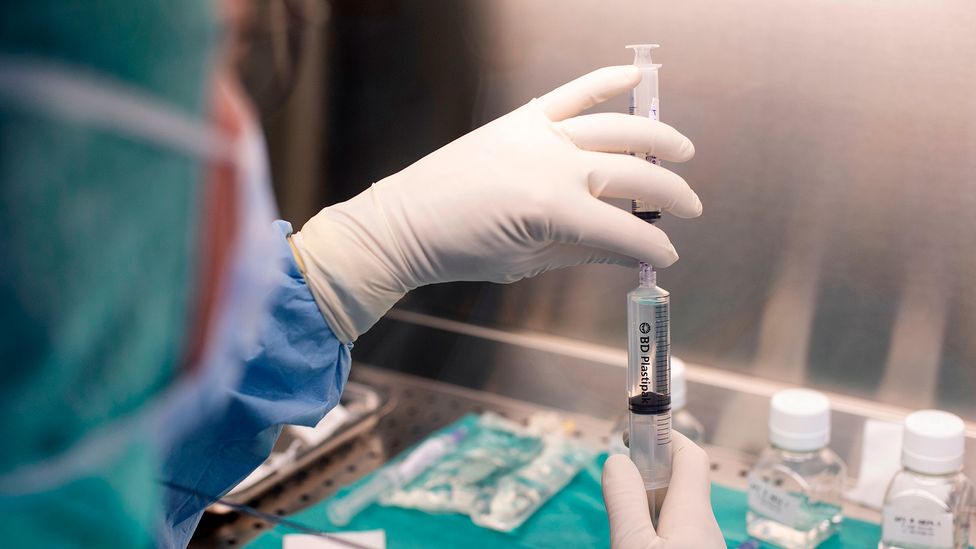
Article continues below
Three years ago, Esteban Diaz was advised by his doctors to get on the lung transplant list after a life-long battle with cystic fibrosis. The disease causes excessive production of mucus in the lungs and pancreas, leaving patients extremely vulnerable to bacterial infections. In the 47-year-old Frenchman’s case, the antibiotics he had been prescribed since childhood were no longer effective against incessant infections caused by Pseudomonas aergonisa, a bacteria now classified as a superbug.
Instead, Diaz (not his real name) travelled to Georgia, a former Soviet state on the Black Sea, to undergo phage therapy, a medical treatment he says cleared up his infections within days and relieved him of the persistent fatigue, relentless coughing and breathlessness that plagued him for decades.
Phages or bacteriophages are viruses that naturally prey on bacteria by infecting and replicating within them until they burst out, killing their microbial host. There are billions of phages on Earth, and they have co-evolved with the bacteria they prey on for millennia, helping to keep their numbers in check.
Their therapeutic use was first pioneered in 1919 by Felix d’Herelle, a French-Canadian microbiologist who used phages to cure a boy suffering from severe dysentery. However, the discovery of penicillin in 1928 and its subsequent commercial production by the 1940s unleashed the antibiotic era, effectively supplanting phage therapy.
You might also like:
- The viruses that may save humanity
- The deadly germ warfare island abandoned by the Soviets
- Why the world needs viruses to function
The therapeutic role of phages might have been all but forgotten if not for the collaboration between d’Herelle and George Eliava, a young Georgian scientist who had travelled to France in 1923. He had arrived with the aim of studying the development of vaccines but instead turned his attention to phages after meeting d’Herelle at the Pasteur Institute.
Eliava returned to Georgia and invited d’Herelle to help set up the world’s first research institute and therapeutic centre dedicated to bacteriophages, just as the country was being absorbed into the Soviet Union.
Sadly, like thousands of intellectuals of the time, Eliava fell foul of Josef Stalin’s regime and was executed in 1937. But Soviet patronage of the research and development of therapeutic phages continued at the institute Eliava founded, years after the Western world sidelined the approach.
Story continues below
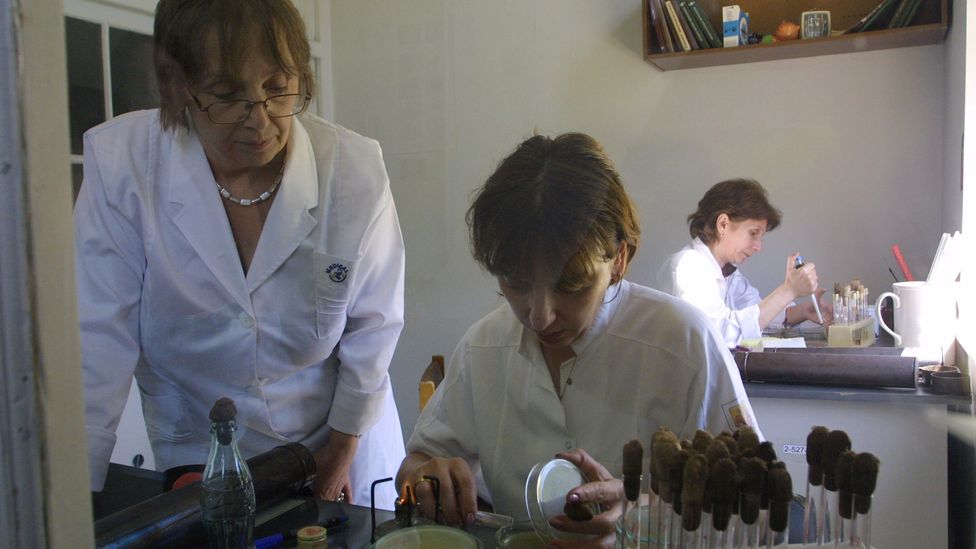
After the fall of the Soviet Union, the Eliava Institute continued research into the disease-fighting abilities of bacteriopages (Credit: Vano Shlamov/AFP/Getty Images)
“Phage therapy was part of the standard health care system during the Soviet Union,” says Mzia Kutateladze, director of the Eliava Institute. “Depending on the health status of the patient and the type of infection, doctors would make a call on whether to use phages or antibiotics or a combination of both.”
The institute, however, faced severe difficulties in the years following the break-up of the Soviet Union. Some researchers resorted to storing phage cultures in their own homes to save them. But it would soon play a key role in reintroducing the world to the scope and potential of phage therapy.
“It took a long time before people were convinced that phages can be used therapeutically," says Kutateladze. "But antibiotic resistance supported the necessity to find alternatives.” The institute faced enormous challenges when it started presenting its work internationally in the late 1990s. But in 2001, it received its first foreign patient soon after a conference in Montreal – a Canadian suffering from a bacterial bone infection called osteomyelitis that antibiotics hadn’t been able to cure. The treatment worked, and thanks to a flurry of news articles which followed, international patients started trickling into the Eliava Institute.
By the fourth day of treatment it was as if someone had taken back my sickness – Esteban Diaz
The World Health Organization (WHO) has called antimicrobial resistance (AMR) a global health crisis, with up to 30 million people expected to be affected by 2050. For cystic fibrosis patients like Diaz, antibiotic resistance was the inevitable fallout of a lifetime of prescription to the drugs.
“From the time I was seven years old till I was 17… every three months, I would be systematically bombarded with two different kinds of antibiotics – this was the protocol back in the day,” says Diaz. By the time he was in his 30s, he had also developed chronic tinnitus as a side effect of the continued use of aminoglycosides, the most common antibiotic family used to treat pseudomonas infections like his. By his 40s, resistance had set in and double lung transplantation was the only option his doctors in France could suggest to prolong his life.
After coming across a documentary about the Eliava Institute’s phage therapy on a French TV channel, he booked a trip. “By the fourth day of treatment it was as if someone had taken back my sickness. I slept through the night for the first time in years. It’s hard to describe… I could almost sense the oxygen coursing through my lungs. It was incredible,” he says.
Since his first visit, Diaz regularly returned to Tbilisi to stock up on oral doses of phages preparations that have helped keep subsequent infections in check. That was until he ran out of phages in March this year, just as Georgia closed its borders in its effort to tackle the spread of the coronavirus. As soon as travel restrictions were loosened, Diaz returned for another round of treatment that he said immediately eased a persistent cough he had picked up in the meantime.
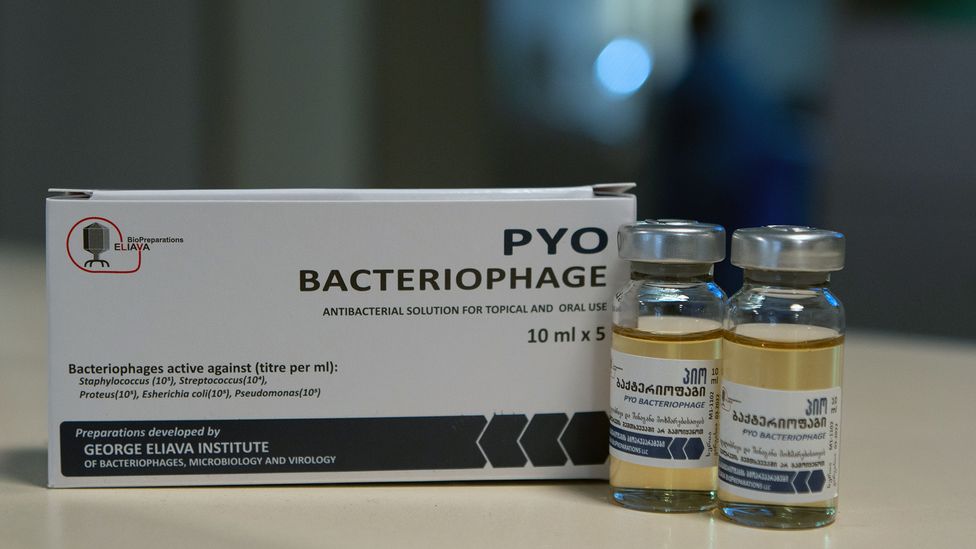
The institute has been a world leader in bacteriophage research since the 1930s (Credit: Pearly Jacob)
But his treatment hasn't been without complications. Diaz fears he might lose his benefits if he is found to have travelled to Georgia for treatment, especially during a pandemic. He adds his personal doctors and a leading cystic fibrosis support group in France have also repeatedly cautioned patients like him against using phages for treatment as it is not yet approved for use in Western countries.
But this hasn’t stopped hundreds of foreign patients seeking phage treatments in Georgia, with a handful of niche medical tour agencies catering to them. Frenchman Alain Lavit and his Georgian wife Irma Jejeia have been assisting patients like Diaz through their agency Caucasus Healing since 2016. A majority of their clients are French, and while a few have openly spoken with the media about their phage treatments, Lavit says patients with chronic illnesses like cystic fibrosis prefer to maintain anonymity due to the complex lifelong relationships they develop with their doctors back home.
“It’s not illegal to go abroad for treatment, but many of the cystic fibrosis patients we’ve worked with are worried about offending their pulmonologists whom they’ve seen since childhood and most doctors know nothing about phage therapy so they always advise against it,” says Lavit. A clause in the French disability pension system, for instance, stipulates patients should seek employment once they recover from their illness, making it a tricky situation for people with chronic illnesses to report any improvement in their symptoms. “Phage therapy does not cure them, but it helps their condition,” Lavit adds.
It’s very difficult to go with the standard classical way of approval. It is not a chemical formula - Mzia Kutateladze
Millions of people were treated with phages in the former Soviet Union, and the Eliava Institute continues to receive and successfully treat hundreds of international patients every year. But it has been just a little over two decades since Western scientists resumed research into phage therapy and conducted clinical trials required to regulate their use as therapeutic medicines.
Phagoburn was the first French-led European clinical trial of phage therapy on infected burn wounds following strict medical guidelines. Partly funded with a €3.8m grant (£3.38m/$4.6m) by the European Commission, it ran between 2013 and 2017 but was terminated early due to reasons including the failure to recruit adequate test subjects and issues in the stability of prepared phages. Moreover, it took two years and a significant amount of the project budget to manufacture phages according to prescribed Good Manufacturing Practices (GMP). While the trial demonstrated phages did help reduce bacterial burden in some patients, it did so at a slower pace than standard treatment.
This was a disappointment for proponents of phage therapy including those at the Eliava Institute. “It is not only the failure of one test… it affects the whole concept,” says Kutateladze, who believes the type of phages, the prescribed doses and application method in the trial was not suited to infection in the test patients. “It’s very difficult to go with the standard classical way of approval. It is not a chemical formula."
Phages have to be matched to the bacteria they infect for the most effective results, she says. The medical preparations also have to be regularly updated, making it harder for them to meet established Western guidelines that designed for conventional antimicrobials.

Mzia Kutateladze, the director of the institute, says phages were a standard medical therapy in the USSR (Credit: Pearly Jacob)
“These are biomedicines and it should benefit from a separate status, especially since they are natural," says Alain Dublanchet, one of the leading advocates of phage therapy in France who has often referred patients to the clinic at the Eliava Institute in Georgia. For him, the result of Phagoburn made it even harder for patients like Diaz to talk openly about how phages helped cure their infections in France.
“The main obstacle seems to lie in the possibility of producing suspensions of bacteriophages that satisfy the [French] health authorities,” he says. He adds the concentration of phages used in the Phagoburn study were also reduced to be on the safer side of manufacturing guidelines for medicines, a fact brought up in several case studies on the shortcomings of the trial.
But despite the setback of Phagoburn, its role in saving the lives of US citizen Tom Patterson and British teenage cystic fibrosis patient Isabelle Carnell-Holdaway from deadly superbugs was widely covered. In both cases, phages were specially prepared and administered under compassionate use, a clause that allows the use of experimental medicine as a final resort.
Paul Pirnay believes it’s only a matter of time before personalised phage therapy is accepted as a standard treatment option
Although several developed countries including UK, France and US now allow compassionate use of phages on a case-by-case basis, Dublanchet argues this leaves out many people from receiving the treatment they desperately require. “It seems absurd to wait until the lives of individuals have reached a precarious stage before we are authorised to [treat] their illness,” he says.
Belgium is leading the way as the first developed country to approve the use of phages as magistral preparations, or personalised medication that can prepared by a qualified pharmacist based on a doctor’s prescription. “In Belgium, we spent many years discussing with regulators, but this was a mistake,” says Jean-Paul Pirnay, research director at the Queen Astrid Military Hospital (QAMH) in Brussels. “Regulators liked phage therapy, but they did not have the power nor the mandate to change or bend regulations. It was only when the minister of public health officially asked them to help us that the ball started rolling.”
Pirnay authored a paper outlining recommendations for Belgium’s Magistral Phage Medicine Framework, including a regulatory system to create a seed bank of tested and certified phages needed for personalised preparations. He says there are ongoing plans to export this solution to the European Pharmacopoeia or a pan-EU regulatory solution governing the use of phages, but Covid-19 has slowed momentum.
With these developments, Pirnay believes it’s only a matter of time before personalised phage therapy is accepted as a standard treatment option worldwide. He outlined this in Phage Therapy in the Year 2035 – half scientific paper and half science fiction plot that portrays a bleak future “characterised by human overpopulation, major ecosystem disruptions, global warming, and xenophobia” where AI helps fight diseases by matching the right phages to them.
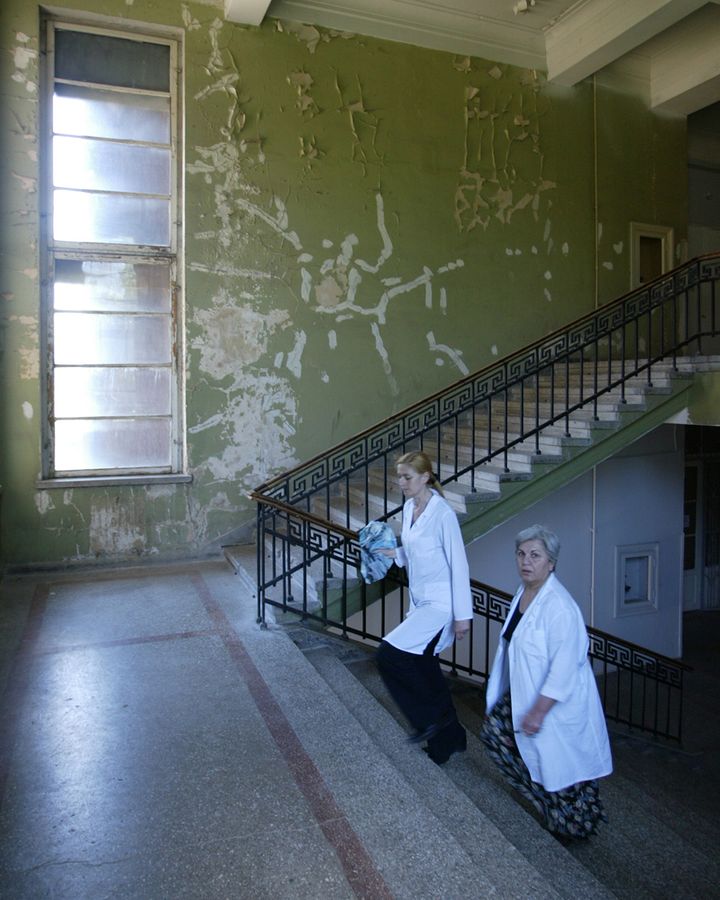
The institute had to struggle on through lean years after Georgia declared independence in the early 1990s (Credit: Vano Shlamov/AFP/Getty Images)
But 2035 is too far away for people ill now. Some 700,000 people currently die every year due to AMR infections. Pirnay said the futuristic allegory was inserted in his paper to highlight the urgent need for a solution. Although the WHO has repeatedly stated the need for prioritising alternatives to antibiotics, it has never officially mentioned the potential of phage therapy. There are also growing demands from phage scientists for the WHO to help channel much required funding into more clinical research and trials of phages for therapeutic use.
Apart from regulatory challenges, phages cannot be patented because they are biological products. This has meant most pharmaceutical companies have shied away from funding research for developing them as medicinal products. Bacteria can also develop resistance to phages over time, an issue that phage researchers and doctors have managed to sidestep so far. They do this by either isolating new phages from the billions of samples available in nature, or training phages in labs to develop new ways to attack the bacteria.
The latter is a process of co-evolution both microbes have been part of for millennia. New research has identified the defensive immunity called Crispr–Cas system that bacteria develop against phages, providing more clues on how to fight potential resistance.
The Eliava Institute should get more credit for what they did - Jean Paul-Pirnay
Research laboratories in countries like the US are now delving into genetically engineered phages and extraction of lysins, the active agent in phages that kill bacteria. This is turn has sparked the interest of pharmaceutical giants as these methods can be patented, unlike the natural phages currently being used for therapeutic use. Last year Johnson & Johnson signed an initial $20m (£15m) deal with Locus Bioscience to research and develop engineered Crispr–Cas3 enhanced phages that could potentially destroy defensive mechanisms bacteria develop.
Amidst the current buzz of unprecedented modern research into phages, the solid and staid work of the Eliava Institute is slowly being overlooked but their contribution to the current global discussion of phages cannot be denied, says Pirnay, who jokingly refers to the fact his team includes two Georgian microbiologists as “Eliava Brussels”.
“The Eliava Institute should get more credit for what they did, but also for what they are still doing,” he says.
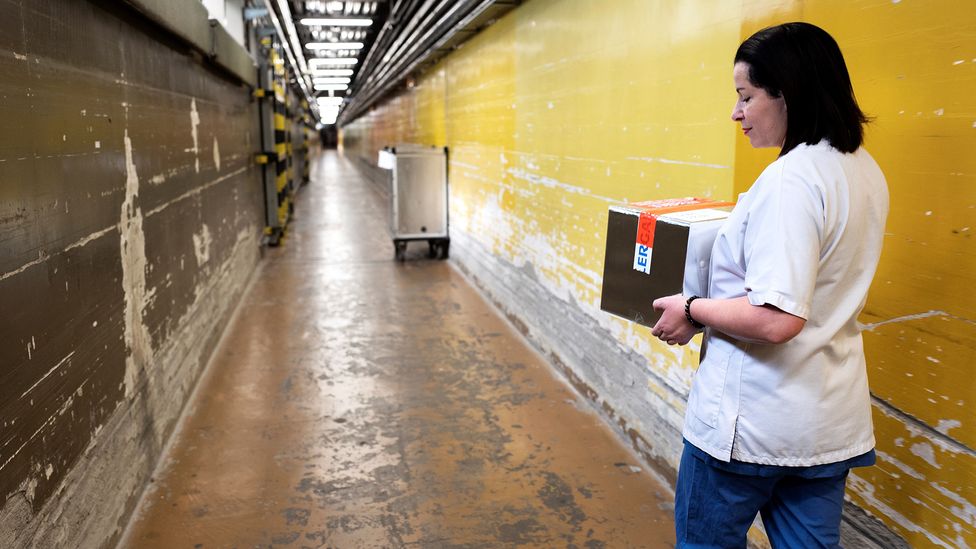
Phages have been trialled in France as a compassionate medicine, something used as a last resort (Credit: Romain Lafrabregue/AFP/Getty Images)
With clinical trials for phages in the West too few and far between, the Eliava Institute has taken to sharing case studies of their patients online. Kutateladze hopes this can help their others focus their research on more crucial matters. “In my opinion there should be a lot more collaboration," she says. "A lot of time and money has been spent on details we have already researched and documented.”
The institute is currently collaborating with Swiss group Ferring Pharmaceuticals and US based company Intralytix, to research and develop phages for treating female reproductive health issues. It is also part of a consortium funded by the EU to study the potential use of phages in treating childhood asthma.
That phage therapy is not a readily available treatment is the biggest scandal of modern medicine – Esteban Diaz
Meanwhile, the Eliava Institute continues to be one of the only clinics in the world where patients can receive phage treatments. The clinic recently started online consultation services to help desperate patients unable to travel to Georgia due to Covid-19. The institute has also been working at updating its production facility to meet GMP standards – a challenging task for the often cash-strapped institute, but one Kutateladze hopes will eventually help ease exports of their medical phage preparations to other countries.
This would be the ideal solution for patients like Diaz. He prefers to travel in person to Tbilisi to renew his stock of phages to avoid customs from intercepting and destroying them, as has happened in the past when he has tried to have them sent by post. “That phage therapy is not a readily available treatment is the biggest scandal of modern medicine,” he says.
--
Join one million Future fans by liking us on Facebook, or follow us on Twitter or Instagram.
If you liked this story, sign up for the weekly bbc.com features newsletter, called “The Essential List”. A handpicked selection of stories from BBC Future, Culture, Worklife, and Travel, delivered to your inbox every Friday.
No comments:
Post a Comment